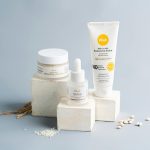In the age of eco-consciousness, one industry that’s quickly adapting to sustainable practices is the beauty industry. The pressing need to reduce environmental impact has led to a shift in the way products are packaged. As consumers, you are increasingly scrutinizing the sustainability of your beauty products, from their sourcing to their packaging. The conversation has taken a turn from just what’s in the products to how they are packaged. As a result, beauty brands are fast turning to sustainable packaging to stay relevant and curb environmental degradation.
This comprehensive guide will enlighten you on the most sustainable practices for disposing of skincare packaging. We delve into the world of eco-friendly, recyclable, and recycled packaging and how these practices are propelling the beauty industry towards sustainability.
Also read : How to Apply Thermal Protection Products Correctly Before Styling Curly Hair with Heat?
Embracing the Use of Recyclable Materials
Defining sustainability in the beauty industry begins by understanding the materials used in product packaging. A significant stride has been made in the use of recyclable materials for the packaging of beauty products.
With the rampant use of plastic and the subsequent waste it produces, there has been a shift towards the use of recyclable materials. This change is driven by both the consumers’ demand for environmentally friendly packaging and the brands’ commitment to reducing their carbon footprint.
Also to read : How to Select Shoes that Offer Both Arch Support and Style for Long Events?
Common recyclable materials include glass, metal, and certain types of plastic. Glass, for example, can be recycled indefinitely without losing its integrity or purity. Metal, on the other hand, is not only recyclable but also extremely durable, making it an excellent choice for reusable packaging. Alternatively, plastic types 1 (PET) and 2 (HDPE) are commonly recycled, making them a better choice than other types of plastic.
Implementing Recycling Programs
Apart from using recyclable materials, another sustainable practice that’s increasingly gaining traction in the beauty industry is the implementation of recycling programs. The main advantage of such programs is they allow consumers to return their used product containers, which can then be recycled and reused.
These programs often offer incentives to motivate customers to return their used product containers. For example, some brands offer discounts or free products in return. This not only encourages recycling but also promotes consumer loyalty towards the brand.
Beauty brands that have implemented such programs have seen a significant reduction in packaging waste, contributing to a more sustainable environment. Recycling programs are an excellent way of ensuring that packaging materials do not end up in landfills but are instead given a new life.
Engaging in Eco-Design
Eco-design is a sustainable practice that involves designing products with consideration for their environmental impact throughout their lifecycle. In the beauty industry, this means designing cosmetic packaging that minimizes waste and maximizes recyclability.
This practice goes beyond simply choosing recyclable materials. It involves the careful selection of inks, adhesives, and finishes that won’t contaminate the recycling process. It also considers the product’s end of life, focusing on designing packages that are easy to disassemble for recycling.
Eco-design not only reduces waste but also saves on resources, as products designed with recycling in mind are easier and cheaper to recycle. This practice is an effective way for beauty brands to contribute to a circular economy.
Advocating for Reusable Packaging
The waste problem in the beauty industry is not just about what happens to packaging after it’s discarded, but also about the sheer volume of packaging used. One approach to reducing packaging waste is through reusable packaging.
Reusable packaging refers to packaging that can be refilled and reused multiple times. This practice significantly reduces the need for new packaging materials, leading to a drastic cut in waste.
Some beauty brands offer refillable products, where once a product is used up, the consumer can purchase a refill instead of a new product. This not only reduces waste but also tends to be more cost-effective for the consumer.
Promoting Consumer Education
Last, but not least, sustainable practices for disposing of skincare packaging include educating consumers. Many consumers are unaware of how to properly dispose of their skincare packaging, leading to recyclable materials ending up in landfills.
Brands can take the initiative to educate their customers about proper disposal methods and the importance of recycling. This can be done through product packaging, social media campaigns, or in-store education.
Consumer education is a powerful tool in driving sustainable change. When consumers are informed about the environmental impact of their actions, they are more likely to make eco-conscious choices, promoting sustainability within the beauty industry.
Reducing Packaging Waste Through Less Packaging
As the beauty industry moves towards sustainable practices, focus on reducing packaging waste has become essential. A significant step in this direction is to use less packaging or minimal packaging for skincare products.
The idea of “less is more” is not only applicable to minimalist design but also in the context of sustainable packaging. While using eco-friendly, recyclable materials is necessary, reducing the amount of packaging used in the first place can have a more significant impact on the environment.
This practice involves reducing the size and weight of packaging, eliminating unnecessary components, and substituting materials where possible. For instance, some brands are doing away with outer carton boxes or reducing the use of plastic wrappers and fillers. By doing so, the beauty industry can considerably reduce the volume of packaging materials required, in turn, minimizing the environmental impact.
Moreover, less packaging equates to less energy consumed in the production process, further diminishing the carbon footprint. It also results in lower transportation costs due to decreased weight and volume, leading to reduced greenhouse gas emissions.
The Role of FSC-Certified and PCR Packaging
In a bid to achieve sustainability, the beauty industry is leveraging FSC-certified and Post-Consumer Recycled (PCR) packaging materials. FSC-certified materials are sourced from responsibly managed forests that provide environmental, social, and economic benefits. PCR materials, on the other hand, are made from discarded consumer products, thereby reducing the need for virgin materials.
FSC-certified packaging is a testament to the responsible sourcing of raw materials, ensuring that the deforestation impact is minimized. It gives consumers the confidence that the cosmetic packaging they are purchasing is not contributing to global deforestation.
PCR packaging plays a vital role in closing the loop of the recycling process. It involves recycling used packaging into new ones, promoting a circular economy. This process reduces the demand for new plastic, decreases landfill waste, and lowers the environmental footprint.
Embracing FSC-certified and PCR packaging is a clear demonstration of a brand’s commitment to sustainability, enhancing its image in the eyes of eco-conscious consumers.
Conclusion
In conclusion, many practices can lead to more sustainable disposal of skincare packaging. From using recyclable materials and implementing recycling programs to embracing eco-design and advocating for reusable packaging, the beauty industry is making strides towards sustainability. Additional practices like reducing packaging waste through less packaging and leveraging FSC-certified and PCR packaging materials further enhance the industry’s commitment to the environment.
While the beauty brands are at the forefront of these changes, consumers too have a role to play. As consumers gain more knowledge and awareness, their purchasing decisions can significantly impact the environment. By choosing brands that prioritize sustainability, consumers can drive change and encourage more brands to adopt environmentally friendly practices. The future of the beauty industry lies in the harmony between sustainable practices and consumer choices, and the time to act is now.










